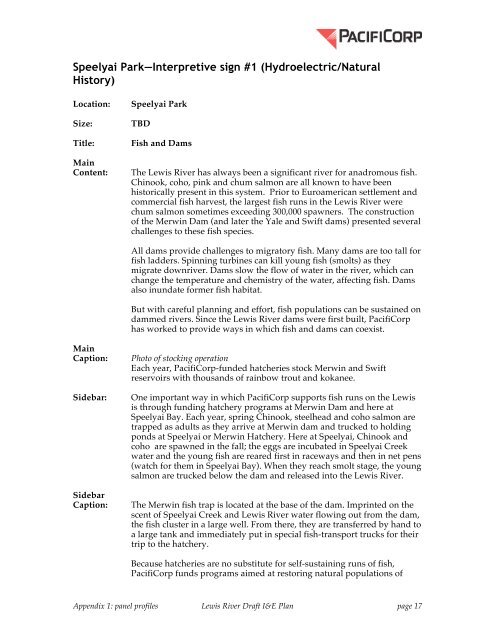The Lewis River Hydroelectric Projects - PacifiCorp
The Lewis River Hydroelectric Projects - PacifiCorp
The Lewis River Hydroelectric Projects - PacifiCorp
Create successful ePaper yourself
Turn your PDF publications into a flip-book with our unique Google optimized e-Paper software.
Speelyai Park—Interpretive sign #1 (<strong>Hydroelectric</strong>/Natural<br />
History)<br />
Location:<br />
Size:<br />
Title:<br />
Main<br />
Content:<br />
Speelyai Park<br />
TBD<br />
Fish and Dams<br />
<strong>The</strong> <strong>Lewis</strong> <strong>River</strong> has always been a significant river for anadromous fish.<br />
Chinook, coho, pink and chum salmon are all known to have been<br />
historically present in this system. Prior to Euroamerican settlement and<br />
commercial fish harvest, the largest fish runs in the <strong>Lewis</strong> <strong>River</strong> were<br />
chum salmon sometimes exceeding 300,000 spawners. <strong>The</strong> construction<br />
of the Merwin Dam (and later the Yale and Swift dams) presented several<br />
challenges to these fish species.<br />
All dams provide challenges to migratory fish. Many dams are too tall for<br />
fish ladders. Spinning turbines can kill young fish (smolts) as they<br />
migrate downriver. Dams slow the flow of water in the river, which can<br />
change the temperature and chemistry of the water, affecting fish. Dams<br />
also inundate former fish habitat.<br />
But with careful planning and effort, fish populations can be sustained on<br />
dammed rivers. Since the <strong>Lewis</strong> <strong>River</strong> dams were first built, <strong>PacifiCorp</strong><br />
has worked to provide ways in which fish and dams can coexist.<br />
Main<br />
Caption:<br />
Sidebar:<br />
Sidebar<br />
Caption:<br />
Photo of stocking operation<br />
Each year, <strong>PacifiCorp</strong>-funded hatcheries stock Merwin and Swift<br />
reservoirs with thousands of rainbow trout and kokanee.<br />
One important way in which <strong>PacifiCorp</strong> supports fish runs on the <strong>Lewis</strong><br />
is through funding hatchery programs at Merwin Dam and here at<br />
Speelyai Bay. Each year, spring Chinook, steelhead and coho salmon are<br />
trapped as adults as they arrive at Merwin dam and trucked to holding<br />
ponds at Speelyai or Merwin Hatchery. Here at Speelyai, Chinook and<br />
coho are spawned in the fall; the eggs are incubated in Speelyai Creek<br />
water and the young fish are reared first in raceways and then in net pens<br />
(watch for them in Speelyai Bay). When they reach smolt stage, the young<br />
salmon are trucked below the dam and released into the <strong>Lewis</strong> <strong>River</strong>.<br />
<strong>The</strong> Merwin fish trap is located at the base of the dam. Imprinted on the<br />
scent of Speelyai Creek and <strong>Lewis</strong> <strong>River</strong> water flowing out from the dam,<br />
the fish cluster in a large well. From there, they are transferred by hand to<br />
a large tank and immediately put in special fish-transport trucks for their<br />
trip to the hatchery.<br />
Because hatcheries are no substitute for self-sustaining runs of fish,<br />
<strong>PacifiCorp</strong> funds programs aimed at restoring natural populations of<br />
Appendix 1: panel profiles <strong>Lewis</strong> <strong>River</strong> Draft I&E Plan page 17
















